Evaluating Irrigation Efficiency with Performance Indicators: A Case Study of Citrus in the East of Spain
Abstract
:1. Introduction
2. Literature Review
3. Materials and Methods
3.1. Proposed Indicators
3.2. Sources of Information
3.3. Variables Included in the Database
3.4. Methodology for Data Analyses
4. Results
4.1. General Analysis of Characteristics of Included Orchards in the Database
4.2. Analysis of Productivity and Applied Irrigation of Selected Varieties
4.3. Analysis of Proposed Indicators
4.3.1. Evolution of Values for Each Indicator
4.3.2. Effect of Different Factors on Indicators
4.3.3. Effect of Combined Factors on Indicators
4.4. The Use of Indicators in ANN to Establish Recommendations
4.4.1. Definition of Selected ANN
4.4.2. Results of Selected Artificial Neural Network
5. Discussion
5.1. The Confusing Effect of ETc and IRn on the Service Delivery Performance Indicator
5.2. The Motivations behind the Orchards with Extra Irrigation and the General Tendency of Increasing the Applied Irrigation
5.3. Are the Profesional Farmers More Efficient in Water Management Than Non-Profesional Farmers?
5.4. The Changes in the Varieties and Their Efficiency in the Water Use
5.5. The Benefits of Including More Information
5.6. The Selected Indicators
6. Conclusions
Author Contributions
Funding
Acknowledgments
Conflicts of Interest
References
- Spiegal, S.; Bestelmeyer, B.T.; Archer, D.W.; Augustine, D.J.; Boughton, E.H.; Boughton, R.K.; Hapeman, C.J. Evaluating strategies for sustainable intensification of US agriculture through the Long-Term Agroecosystem Research network. Environ. Res. Lett. 2018, 13, 34031. [Google Scholar] [CrossRef]
- Gold, M.V. Sustainable agriculture: The basics. Sustain. Agric. Food Supply Sci. Econ. Policy Enhanc. 2016, 1, 3–17. [Google Scholar]
- FAO. The Future of Food and Agriculture–Trends and Challenges; Annual Report; FAO: Rome, Italy, 2017. [Google Scholar]
- Cazcarro, I.; Duarte, R.; Martín-Retortillo, M.; Pinilla, V.; Serrano, A. How sustainable is the increase in the water footprint of the Spanish agricultural sector? A Provincial Analysis between 1955 and 2005–2010. Sustainability 2015, 7, 5094–5119. [Google Scholar] [CrossRef] [Green Version]
- Cazcarro, I.; Duarte, R.; Martín-Retortillo, M.; Pinilla, V.; Serrano, A. Water scarcity and agricultural growth in Spain: From curse to blessing. Nat. Resour. Econ. Growth Learn. Hist. 2015, 339–361. [Google Scholar] [CrossRef]
- Levidow, L.; Zaccaria, D.; Maia, R.; Vivas, E.; Todorovic, M.; Scardigno, A. Improving water-efficient irrigation: Prospects and difficulties of innovative practices. Agric. Water Manag. 2014, 146, 84–94. [Google Scholar] [CrossRef] [Green Version]
- Van Grinsven, H.J.; van Eerdt, M.M.; Westhoek, H.; Kruitwagen, S. Benchmarking eco-efficiency and footprints of Dutch agriculture in European context and implications for policies for climate and environment. Front. Sustain. Food Syst. 2019, 3, 13. [Google Scholar] [CrossRef] [Green Version]
- Weststrate, J.; Dijkstra, G.; Eshuis, J.; Gianoli, A.; Rusca, M. The sustainable development goal on water and sanitation: Learning from the millennium development goals. Soc. Indic. Res. 2019, 143, 795–810. [Google Scholar] [CrossRef] [Green Version]
- Azad, M.A.; Ancev, T. Measuring environmental efficiency of agricultural water use: A Luenberger environmental indicator. J. Environ. Manag. 2014, 145, 314–320. [Google Scholar] [CrossRef]
- Nam, W.H.; Hong, E.M.; Choi, J.Y. Assessment of water delivery efficiency in irrigation canals using performance indicators. Irrig. Sci. 2016, 34, 129–143. [Google Scholar] [CrossRef]
- Sabiha, N.E.; Salim, R.; Rahman, S.; Rola-Rubzen, M.F. Measuring environmental sustainability in agriculture: A composite environmental impact index approach. J. Environ. Manag. 2016, 166, 84–93. [Google Scholar] [CrossRef] [Green Version]
- Van Pham, L.; Smith, C. Drivers of agricultural sustainability in developing countries: A review. Environ. Syst. Decis. 2014, 34, 326–341. [Google Scholar] [CrossRef]
- Malano, H.; Burton, M. Guidelines for Benchmarking Performance in the Irrigation and Drainage Sector; International Programme for Technology and Research in Irrigation and Drainage; FAO: Rome, Italy, 2001; p. 43. [Google Scholar]
- Knox, J.W.; Daccache, A.; Hess, T.M.; Else, M.; Kay, M.; Burton, M.; Malano, H. Benchmarking agricultural water use and productivity in key commodity crops. In WU0122–Final Report for Defra; Cranfield University: Bedford, UK, 2013; p. 66. [Google Scholar]
- Santiago-Brown, I.; Metcalfe, A.; Jerram, C.; Collins, C. Sustainability assessment in wine-grape growing in the new world: Economic, environmental, and social indicators for agricultural businesses. Sustainability 2015, 7, 8178–8204. [Google Scholar] [CrossRef] [Green Version]
- Todorovic, M.; Mehmeti, A.; Scardigno, A. Eco-efficiency of agricultural water systems: Methodological approach and assessment at meso-level scale. J. Environ. Manag. 2016, 165, 62–71. [Google Scholar] [CrossRef] [PubMed]
- Saladini, F.; Betti, G.; Ferragina, E.; Bouraoui, F.; Cupertino, S.; Canitano, G.; Bidoglio, G. Linking the water-energy-food nexus and sustainable development indicators for the Mediterranean region. Ecol. Indic. 2018, 91, 689–697. [Google Scholar] [CrossRef]
- CROPWAT 8.0 Bèta Software. Available online: https://cropwat.informer.com/ (accessed on 9 August 2020).
- Land and Water Development Division of FAO, Recommendations for CROPWAT Use. Available online: http://www.fao.org/land-water/databases-and-software/cropwat/en/ (accessed on 9 August 2020).
- SIAR Database for CLimati Data. Available online: www.siar.es (accessed on 9 August 2020).
- Todorovic, M.; Karic, B.; Pereira, L.S. Reference evapotranspiration estimate with limited weather data across a range of Mediterranean climates. J. Hydrol. 2013, 481, 166–176. [Google Scholar] [CrossRef] [Green Version]
- Awal, R.; Habibi, H.; Fares, A.; Deb, S. Estimating reference crop evapotranspiration under limited climate data in West Texas. J. Hydrol. Reg. Stud. 2020, 28, 100677. [Google Scholar] [CrossRef]
- Tomas-Burguera, M.; Vicente-Serrano, S.M.; Grimalt, M.; Beguería, S. Accuracy of reference evapotranspiration (ETo) estimates under data scarcity scenarios in the Iberian Peninsula. Agric. Water Manag. 2017, 182, 103–116. [Google Scholar] [CrossRef] [Green Version]
- Stagraphics Centurion XVI software. Available online: https://www.statgraphics.com (accessed on 8 August 2020).
- Dahikar, S.S.; Rode, S.V. Agricultural crop yield prediction using artificial neural network approach. Int. J. Innov. Res. Electr. Electron. Instrum. Control Eng. 2014, 2, 683–686. [Google Scholar]
- Umair, S.M.; Usman, R. Automation of irrigation system using ANN based controller. Int. J. Electr. Comput. Sci. IJECS-IJENS 2010, 10, 41–47. [Google Scholar]
- Karasekreter, N.; Başçiftçi, F.; Fidan, U. A new suggestion for an irrigation schedule with an artificial neural network. J. Exp. Theor. Artif. Intell. 2013, 25, 93–104. [Google Scholar] [CrossRef]
- Kelley, J.; Pardyjak, E.R. Using neural networks to estimate site-specific crop evapotranspiration with low-cost sensors. Agronomy 2019, 9, 108. [Google Scholar] [CrossRef] [Green Version]
- Mesejo, C.; Martínez-Fuentes, A.; Reig, C.; Balasch, S.; Primo-Millo, E.; Agustí, M. Mechanical pruning attenuates alternate bearing in ‘Nadorcott’mandarin. Sci. Hortic. 2020, 261, 108993. [Google Scholar] [CrossRef]
- Parra, M.; Parra, L.; Rocher, J.; Lloret, J.; Mauri, P.V.; Llinares, J.V. A Novel Low-Cost Conductivity Based Soil Moisture Sensor. In Proceedings of the International Conference on Advanced Intelligent Systems for Sustainable Development 2019, Marrakech, Morocco, 8–11 July 2019; Springer: Cham, Switzerland, 2019; pp. 27–35. [Google Scholar]
- Marín, J.; Yousfi, S.; Mauri, P.V.; Parra, L.; Lloret, J.; Masaguer, A. RGB Vegetation Indices, NDVI, and Biomass as Indicators to Evaluate C3 and C4 Turfgrass under Different Water Conditions. Sustainability 2020, 12, 2160. [Google Scholar] [CrossRef] [Green Version]
- Cammalleri, C.; Anderson, M.C.; Gao, F.; Hain, C.R.; Kustas, W.P. Mapping daily evapotranspiration at field scales over rainfed and irrigated agricultural areas using remote sensing data fusion. Agric. For. Meteorol. 2014, 186, 1–11. [Google Scholar] [CrossRef] [Green Version]
- Chai, Q.; Gan, Y.; Zhao, C.; Xu, H.L.; Waskom, R.M.; Niu, Y.; Siddique, K.H. Regulated deficit irrigation for crop production under drought stress. A review. Agron. Sustain. Dev. 2016, 36, 3. [Google Scholar] [CrossRef] [Green Version]
- Yu, L.; Zhao, X.; Gao, X.; Siddique, K.H. Improving/maintaining water-use efficiency and yield of wheat by deficit irrigation: A global meta-analysis. Agric. Water Manag. 2020, 228, 105906. [Google Scholar] [CrossRef]
- Al-Rousan, W.M.; Ajo, R.Y.; Angor, M.M.; Osaili, T.; Bani-Hani, N.M. Impact of different irrigation levels and harvesting periods on the quantity and quality of Navel oranges (Citrus sinensis) and fruit juice. J. Food Agric. Environ. 2012, 10, 115–119. [Google Scholar]
- García, L.; Parra, L.; Jimenez, J.M.; Lloret, J.; Lorenz, P. IoT-Based Smart Irrigation Systems: An Overview on the Recent Trends on Sensors and IoT Systems for Irrigation in Precision Agriculture. Sensors 2020, 20, 1042. [Google Scholar] [CrossRef] [Green Version]
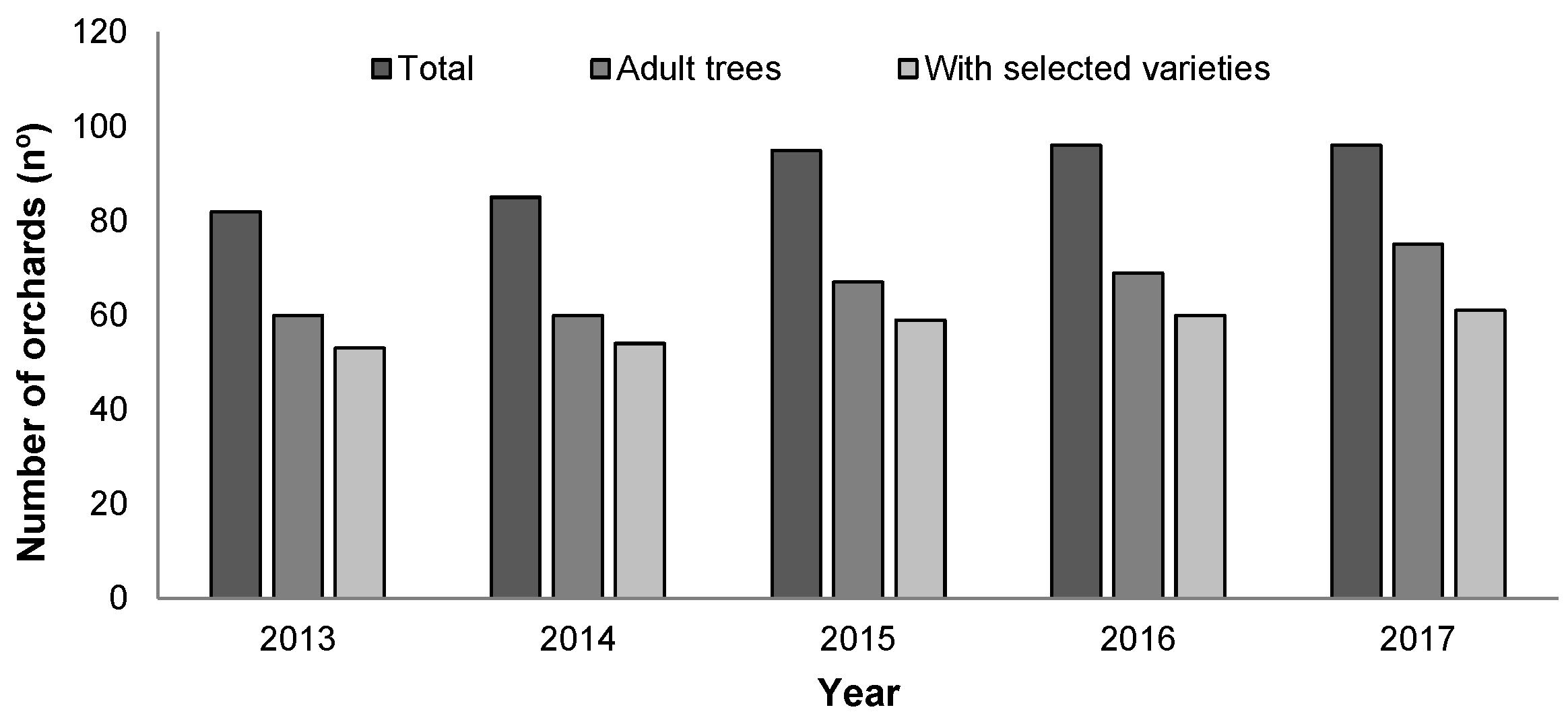
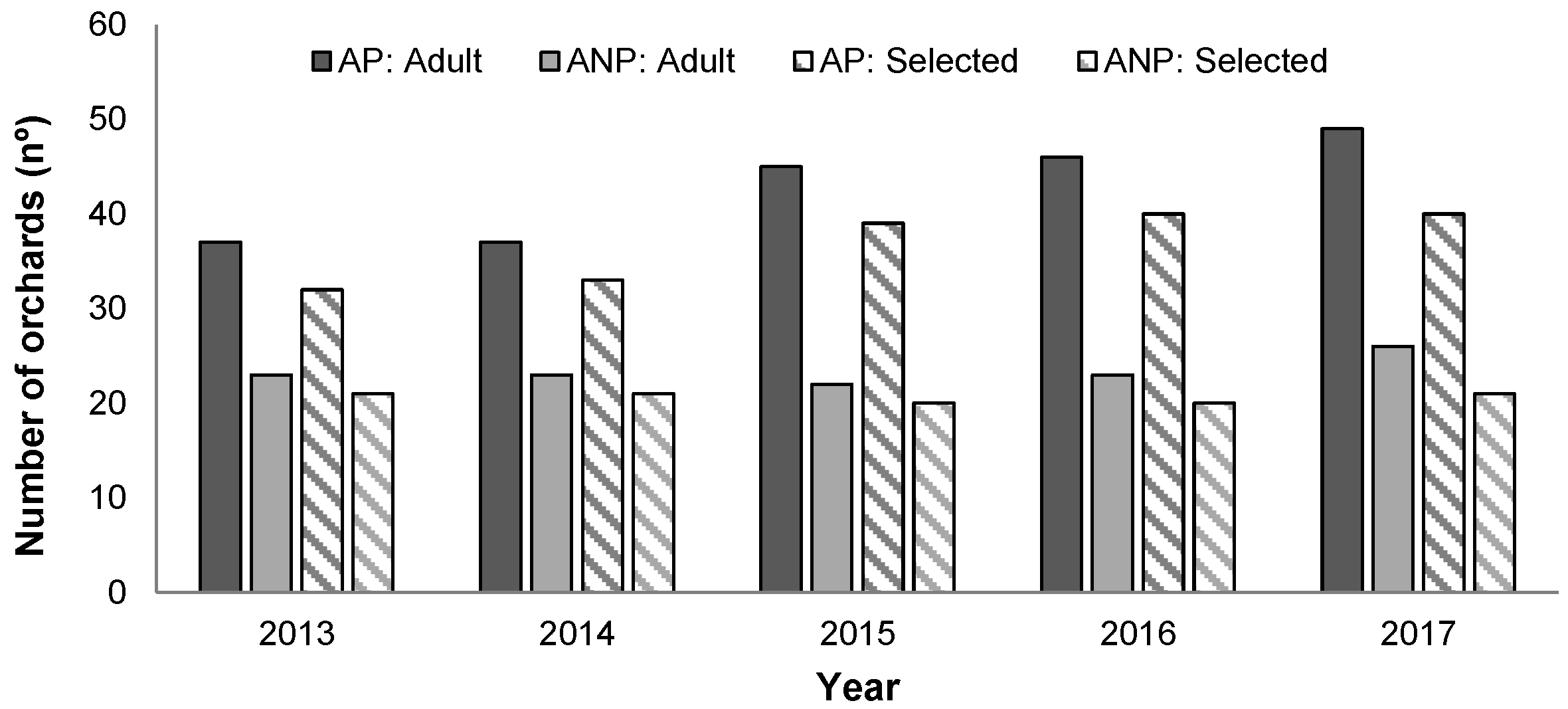
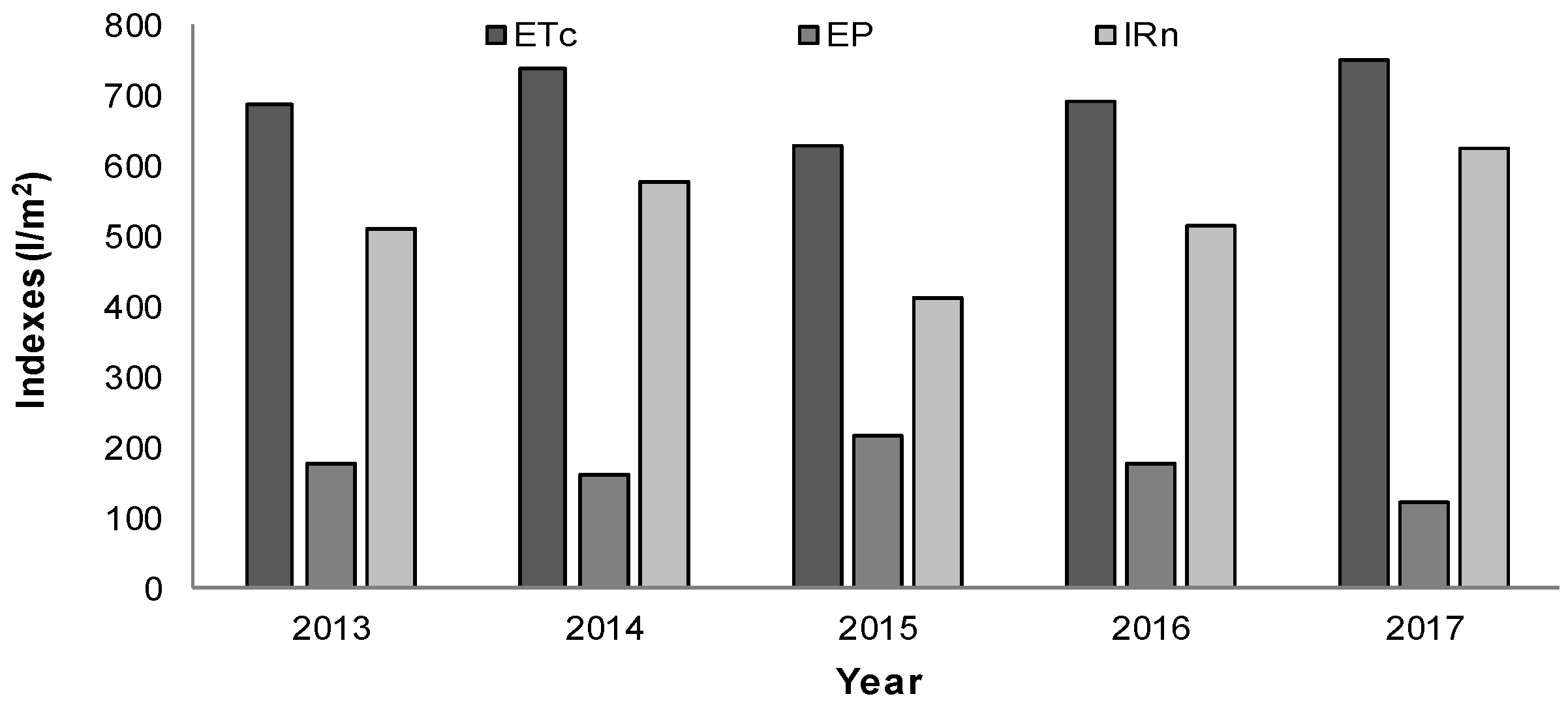
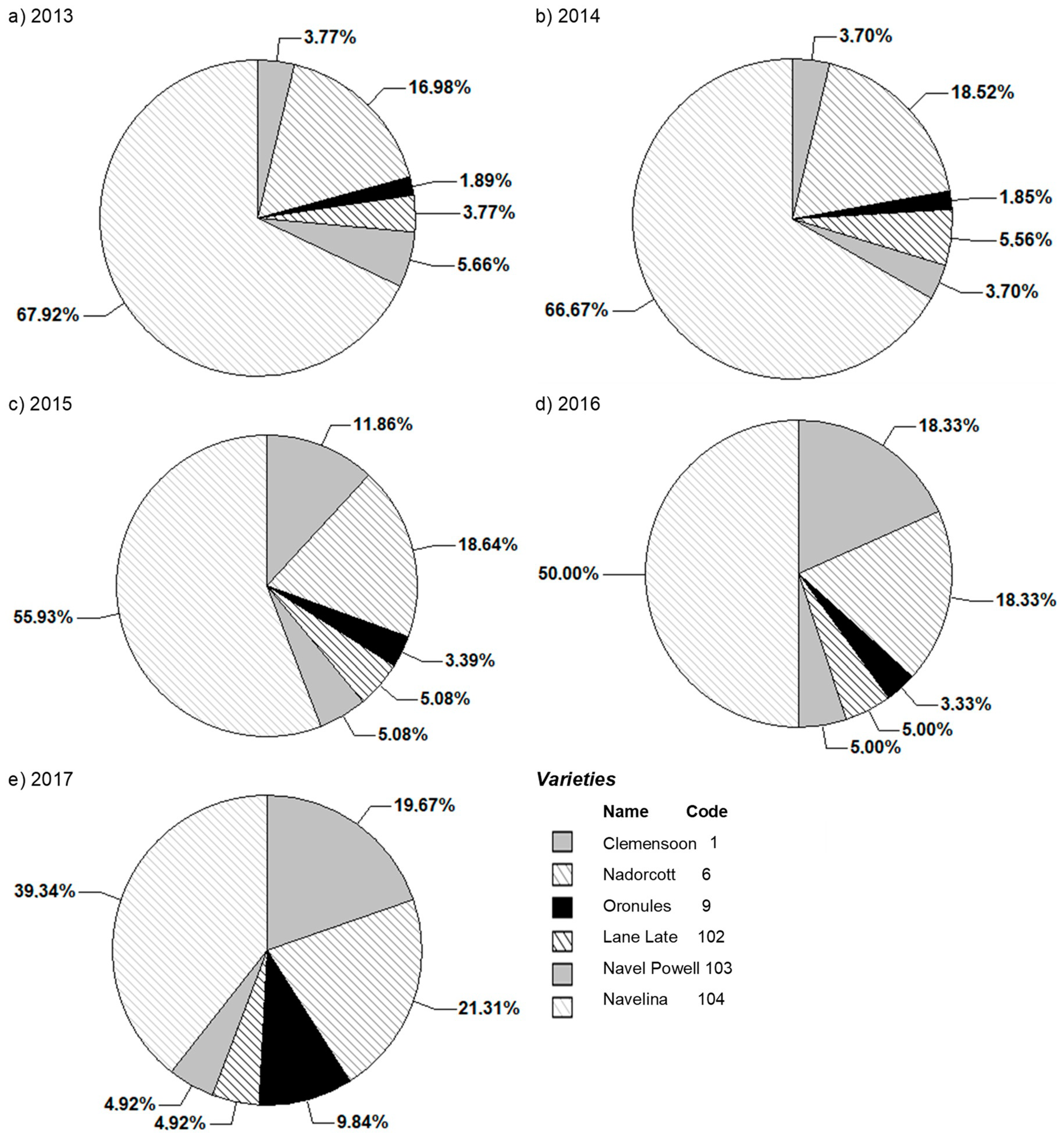
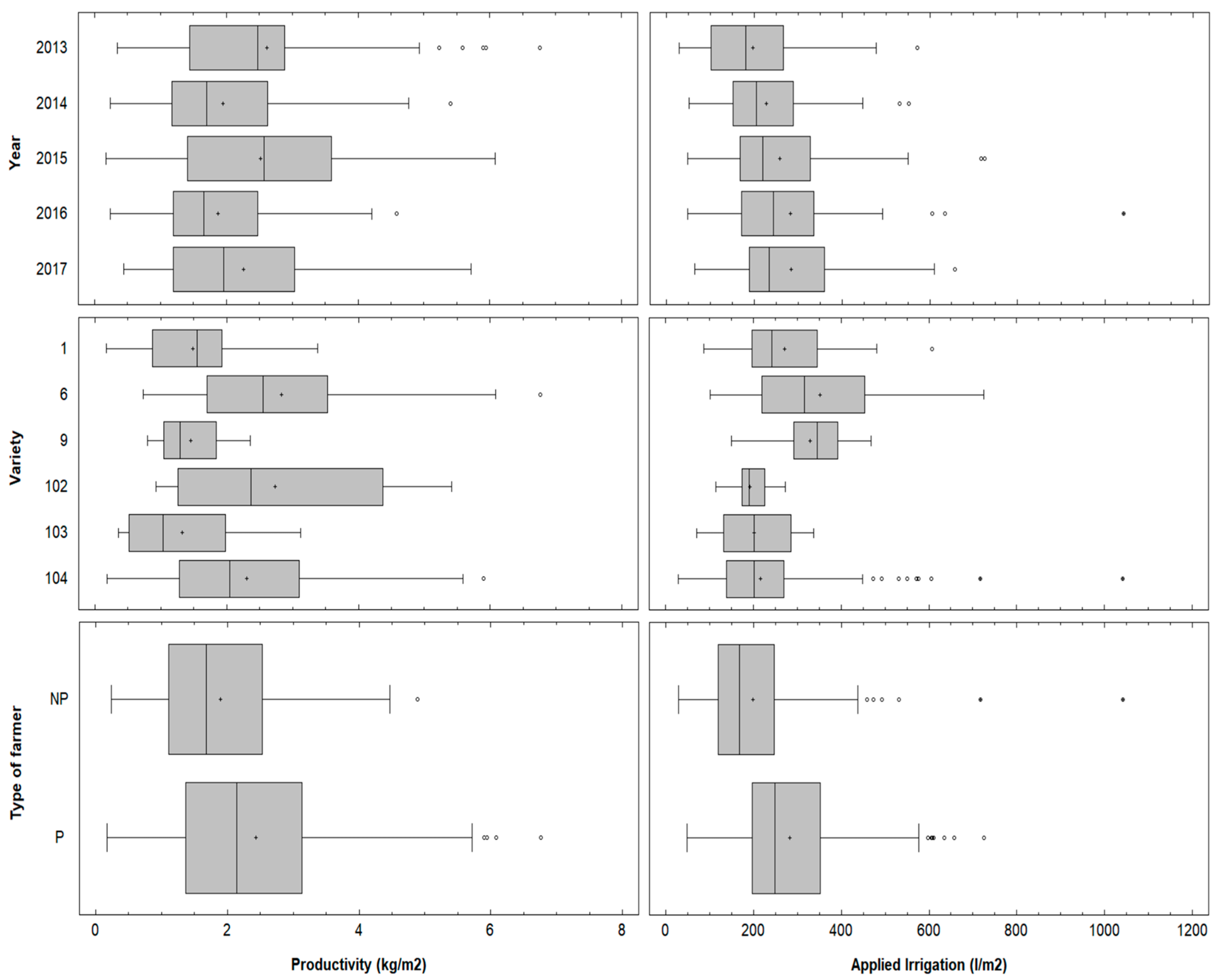
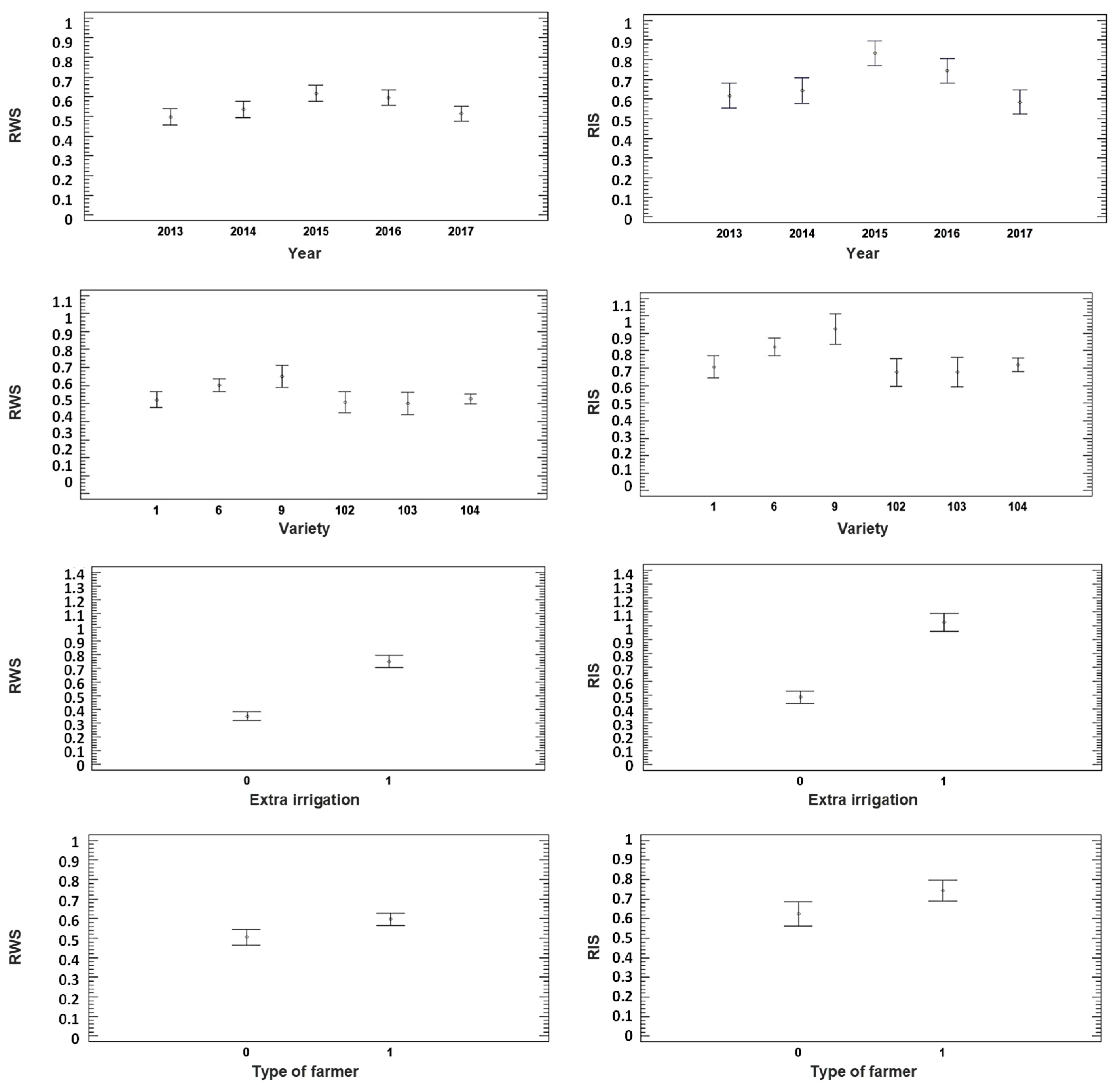
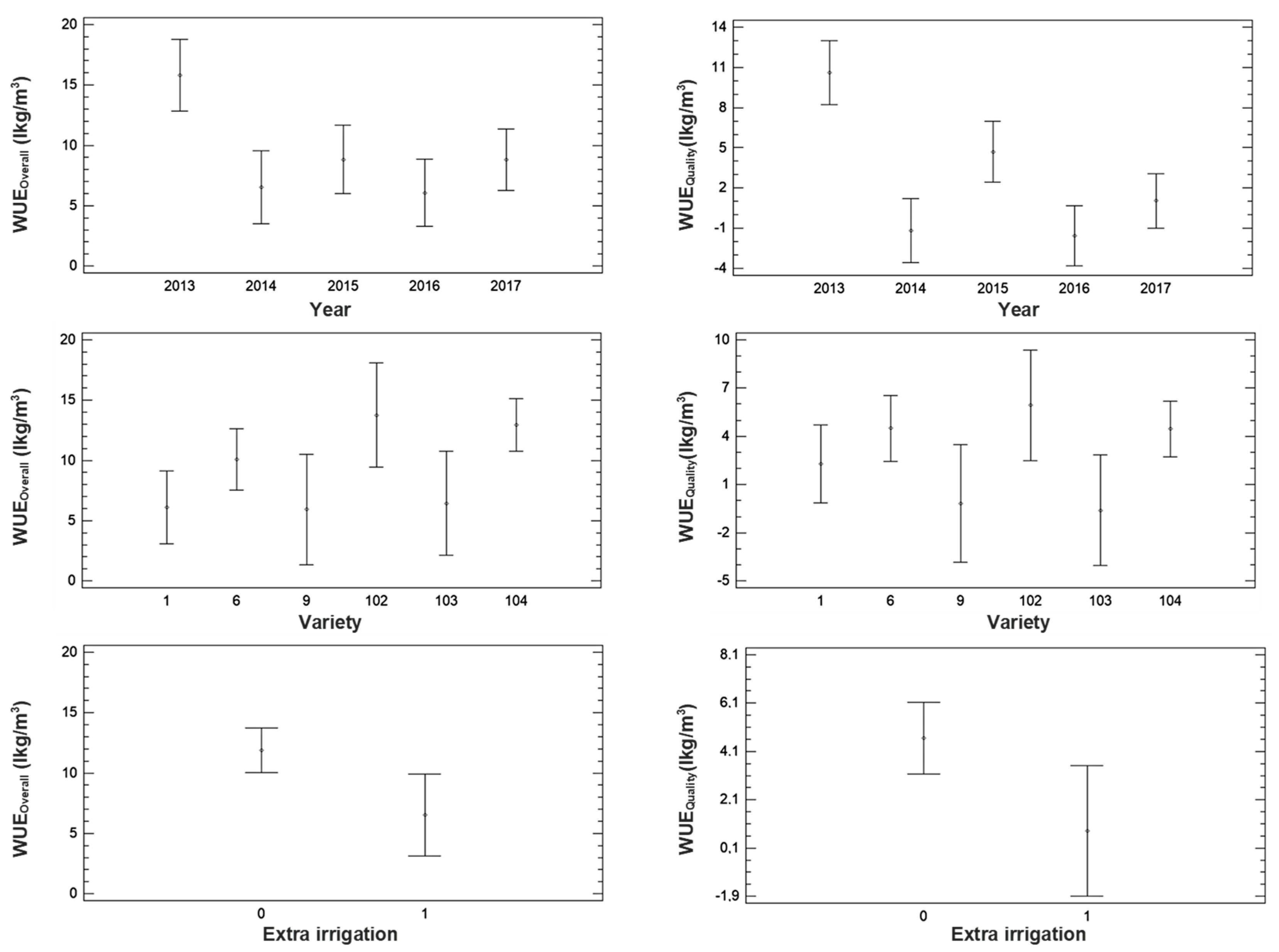
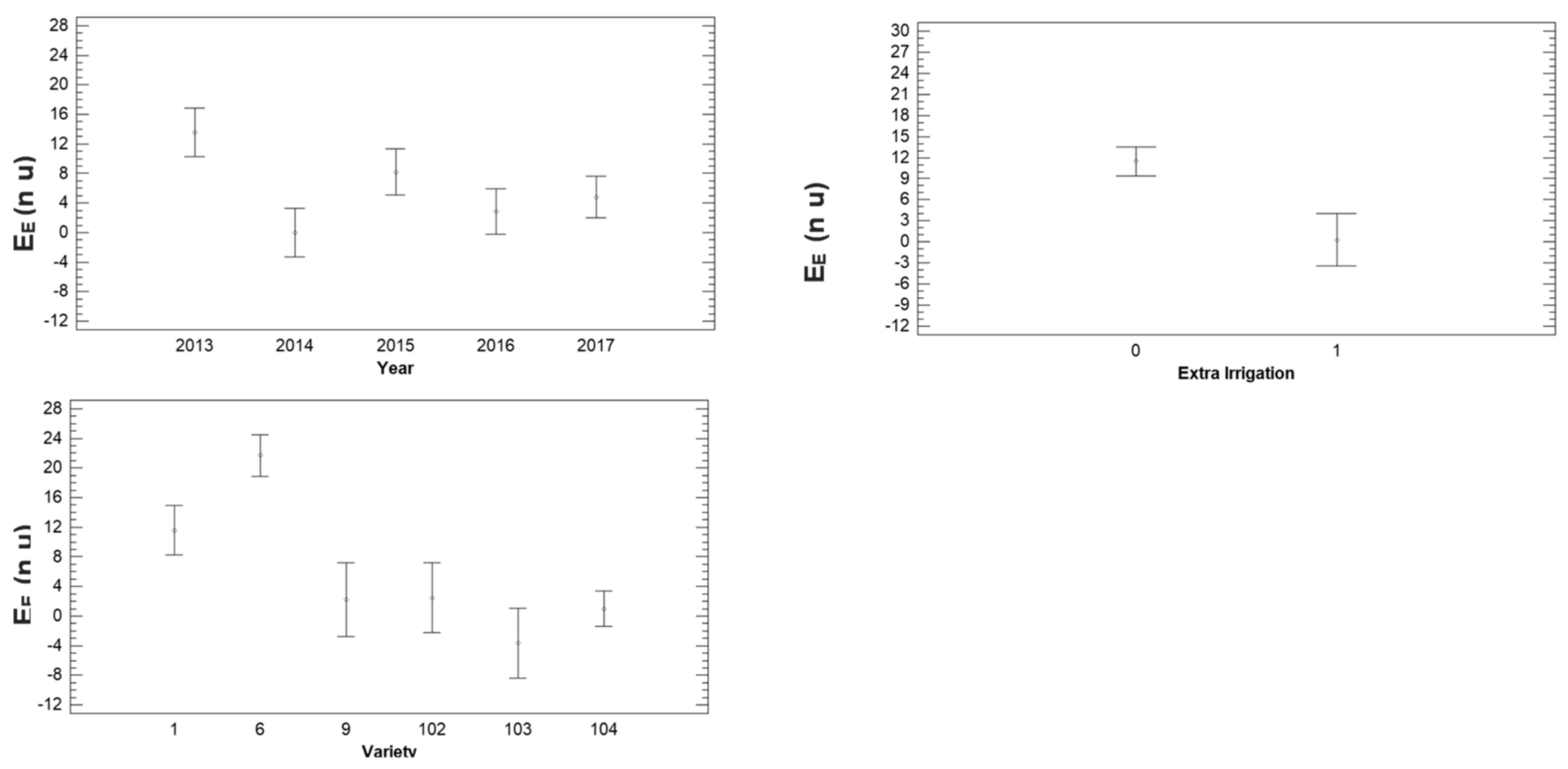
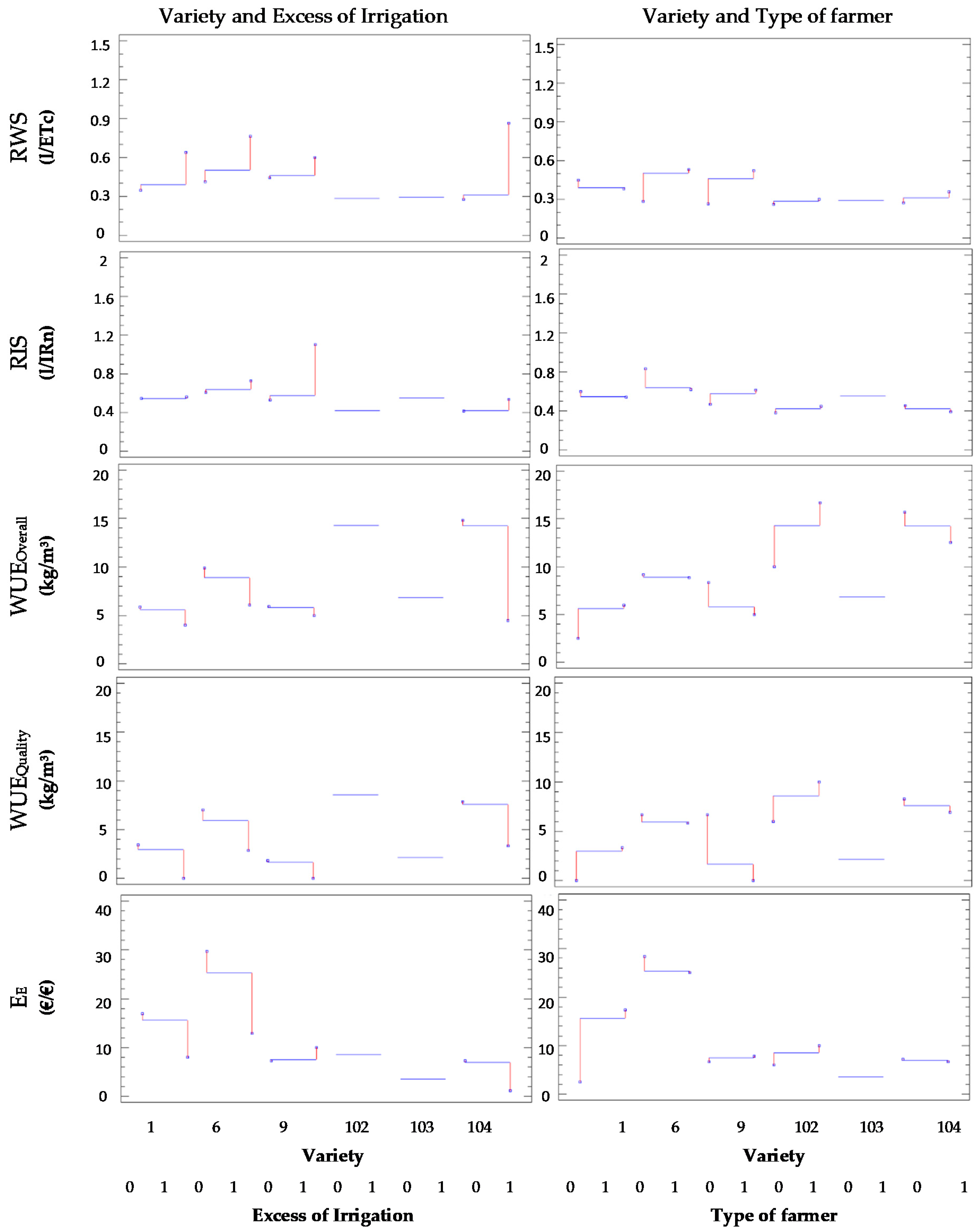
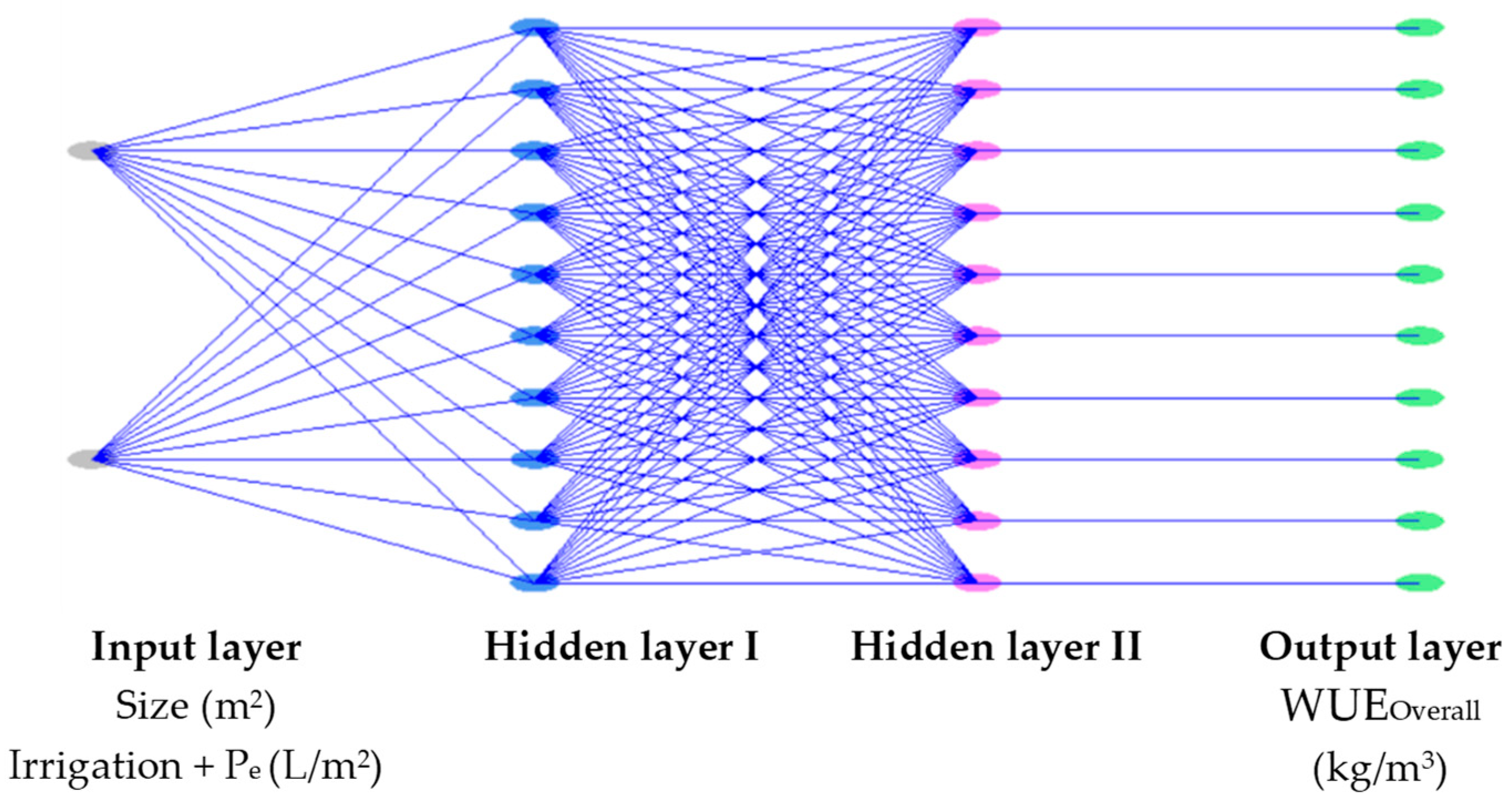
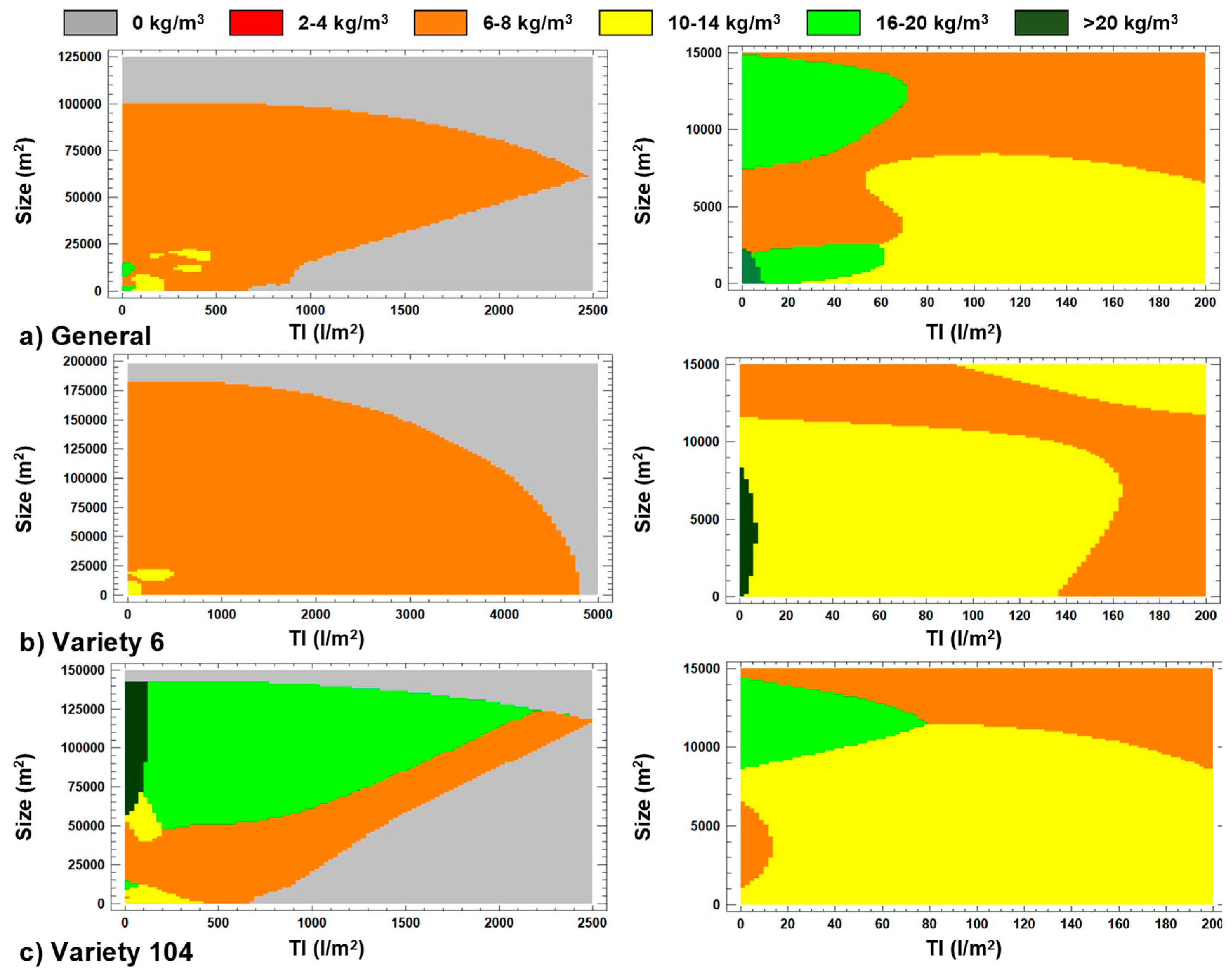
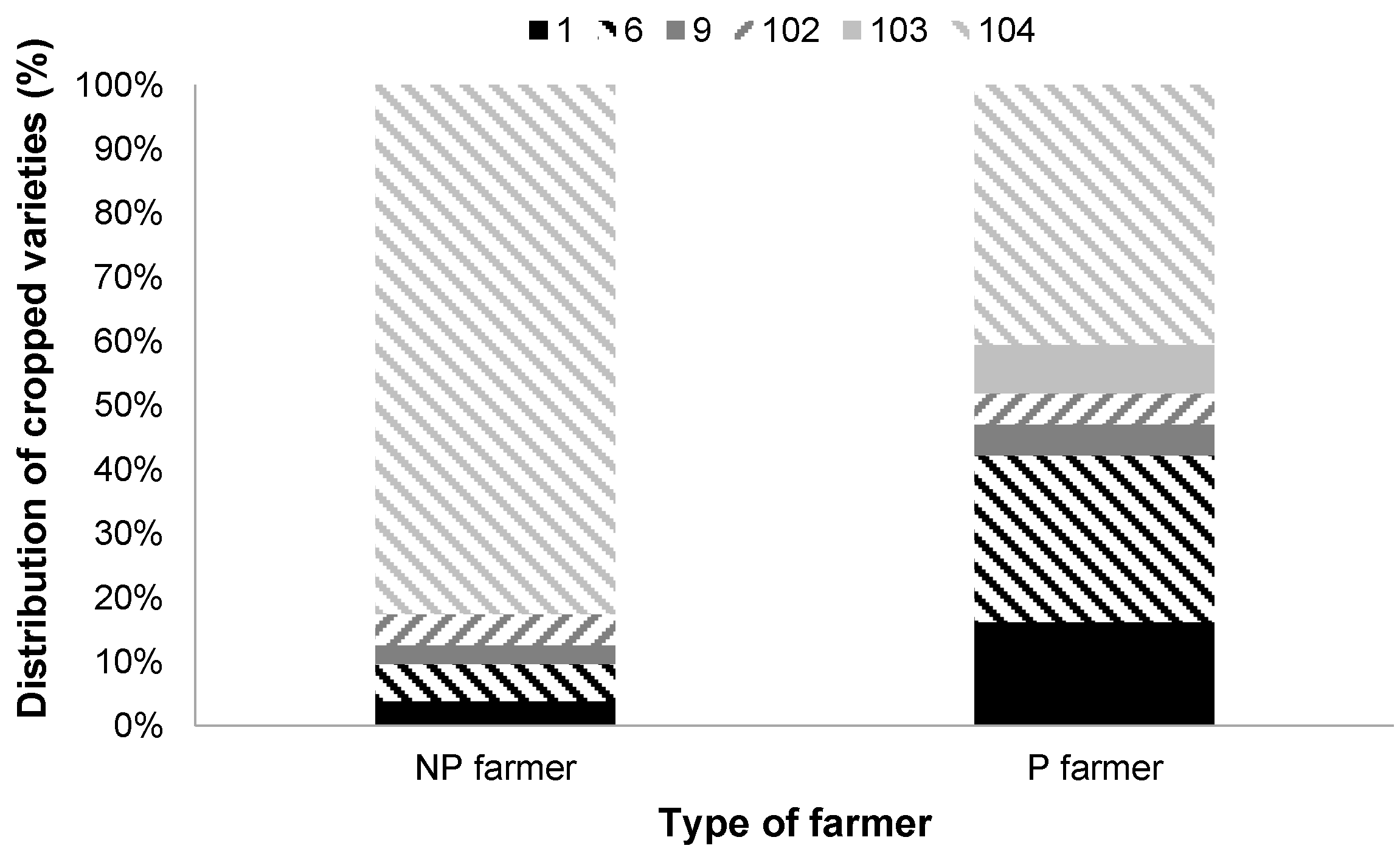
| Variable | Units/Categories | Source |
|---|---|---|
| Type of farmer | P/NP | Cooperative of farmers |
| Type of species | Tangerines/Oranges | Cooperative of farmers |
| Type of variety | Clemensoon (1) Nadorcott (6) Oronules (9) Lane Late (102) Navel Powell (103) Navelina (104) | Cooperative of farmers |
| Type of tree status | Young/Graphted/Adult | Cooperative of farmers |
| Type of size of the orchard | Small/Medum/Large | Cooperative of farmers |
| Size of orchard | (m2) | Cooperative of farmers |
| Total production | (kg) | Cooperative of farmers |
| Production: big grade | (kg) | Cooperative of farmers |
| Production: optimal grade | (kg) | Cooperative of farmers |
| Production: small grade | (kg) | Cooperative of farmers |
| Production: low grade | (kg) | Cooperative of farmers |
| Mean price | (€/kg) | Cooperative of farmers |
| Income | (€) | Cooperative of farmers |
| Total production | (kg/m2) | Cooperative of farmers |
| Irrigation | (m3/year) | Irrigation community |
| Expenditure in regular irrigation | (€/m3 by year) | Irrigation community |
| Expenditure on extra irrigation | (€/m3 by year) | Irrigation community |
| Expenditure in total irrigation | (€/m3 by year) | Irrigation community |
| Irrigation | (l/m2 and year) | Irrigation community |
| Type of extra irrigation | Yes/No | Irrigation community |
| Effective Precipitation (Pe) | (mm/year) | Obtained from SIAR |
| Net Irrigation Requirement (IRn) | (mm/year) | Obtained from SIAR |
| Evapotranspiration of the crop (ETc) | (mm/year) | Obtained from SIAR |
| Year | 2013 | 2014 | 2015 | 2016 | 2017 |
|---|---|---|---|---|---|
| Mean | 2.59 | 1.95 | 2.53 | 1.87 | 2.27 |
| Standard deviation | 1.53 | 1.13 | 1.48 | 1.03 | 1.32 |
| Minimum | 0.35 | 0.24 | 0.18 | 0.24 | 0.44 |
| Maximum | 6.76 | 5.40 | 6.08 | 4.59 | 5.72 |
| Range | 6.41 | 5.16 | 5.90 | 4.35 | 5.28 |
| Year | 2013 | 2014 | 2015 | 2016 | 2017 |
|---|---|---|---|---|---|
| Mean | 197.50 | 228.13 | 259.10 | 282.99 | 284.77 |
| Standard deviation | 120.24 | 110.58 | 142.69 | 456.76 | 148.72 |
| Minimum | 29 | 52 | 49 | 49 | 65 |
| Maximum | 571 | 552 | 725 | 1041 | 658 |
| Range | 542 | 500 | 676 | 992 | 593 |
| Productivity | Applied Irrigation | |||
|---|---|---|---|---|
| Factor | p-Value | Number of Groups 1 | p-Value | Number of Groups 1 |
| Year | 0.0018 | 2 (2013 b, 2014 a, 2015 b, 2016 a, and 2017 ab) | 0.0028 | 3 (2013 a, 2014 ab, 2015 bc, 2016 c, and 2017 c) |
| Variety | 0.0000 | 2 (103 a, 9 a,1 a, 104 b, 102 b, 6 b) | 0.0000 | 4 (102 ab, 103 ab,104 a, 1 bc, 9 cd, and 6 d) |
| Orchard size | 0.7981 | - | 0.0024 | 2 (0 b, 1 a, and 2 b) |
| Type of farmer | 0.0000 | 2 (NP a and P b) | 0.0000 | 2 (NP a and P b) |
| Indicator | Year | 2013 | 2014 | 2015 | 2016 | 2017 |
|---|---|---|---|---|---|---|
| RWS (n u) | Mean | 0.28 | 0.31 | 0.42 | 0.40 | 0.39 |
| Standard deviation | 0.18 | 0.15 | 0.23 | 0.23 | 0.20 | |
| Minimum | 0 | 0.1 | 0.1 | 0.1 | 0.1 | |
| Maximum | 0.8 | 0.7 | 1.2 | 1.5 | 0.9 | |
| Range | 0.8 | 0.6 | 1.1 | 1.4 | 0.8 | |
| RIS (n u) | Mean | 0.38 | 0.40 | 0.62 | 0.55 | 0.48 |
| Standard deviation | 0.23 | 0.20 | 0.35 | 0.31 | 0.25 | |
| Minimum | 0.1 | 0.1 | 0.1 | 0.1 | 0.1 | |
| Maximum | 1.1 | 1 | 1.8 | 2 | 1.1 | |
| Range | 1 | 0.9 | 1.7 | 1.9 | 0.1 | |
| WUEOverall (kg/m3) | Mean | 19 | 10 | 11 | 8 | 10 |
| Standard deviation | 18 | 8 | 10 | 6 | 7 | |
| Minimum | 0.2 | 0.2 | 0.1 | 0.6 | 0.4 | |
| Maximum | 90 | 40 | 50 | 35 | 35 | |
| Range | 90 | 40 | 50 | 35 | 35 | |
| WUEQuality (kg/m3) | Mean | 15 | 3 | 8 | 2 | 4 |
| Standard deviation | 13 | 5 | 9 | 4 | 6 | |
| Minimum | 0 | 0 | 0 | 0 | 0 | |
| Maximum | 70 | 20 | 50 | 20 | 30 | |
| Range | 70 | 20 | 50 | 20 | 30 | |
| EE (n u) | Mean | 18 | 5 | 14 | 9 | 10 |
| Standard deviation | 20 | 7 | 15 | 14 | 8 | |
| Minimum | 0 | 0 | 0 | 0 | 0 | |
| Maximum | 90 | 20 | 80 | 80 | 30 | |
| Range | 90 | 20 | 80 | 80 | 30 |
| Factor | RWS | RIS | WUEOverall | WUEQuality | EE |
|---|---|---|---|---|---|
| Year | 0.0000 | 0.0000 | 0.0000 | 0.0000 | 0.0000 |
| Variety | 0.0002 | 0.0001 | 0.0037 | 0.0747 | 0.0000 |
| Orchard size | 0.0164 | 0.8211 | 0.1783 | 0.2645 | 0.8484 |
| Extra irrigation | 0.0000 | 0.0442 | 0.0107 | 0.0221 | 0.0000 |
| Type of farmer | 0.0004 | 0.0880 | 0.2514 | 0.2569 | 0.5906 |
| Parameters of ANN | Variety | ||
|---|---|---|---|
| Overall | Nadorcott | Navelina | |
| Number of neurons in hidden layer I | 288 | 54 | 159 |
| Number of neurons in hidden layer II | 10 | 10 | 10 |
| Jack-knifing value (optimized during training) | 0.3 | 0.49 | 0.5 |
| % of correct classification | 39.24 | 37.18 | 49.62 |
© 2020 by the authors. Licensee MDPI, Basel, Switzerland. This article is an open access article distributed under the terms and conditions of the Creative Commons Attribution (CC BY) license (http://creativecommons.org/licenses/by/4.0/).
Share and Cite
Parra, L.; Botella-Campos, M.; Puerto, H.; Roig-Merino, B.; Lloret, J. Evaluating Irrigation Efficiency with Performance Indicators: A Case Study of Citrus in the East of Spain. Agronomy 2020, 10, 1359. https://doi.org/10.3390/agronomy10091359
Parra L, Botella-Campos M, Puerto H, Roig-Merino B, Lloret J. Evaluating Irrigation Efficiency with Performance Indicators: A Case Study of Citrus in the East of Spain. Agronomy. 2020; 10(9):1359. https://doi.org/10.3390/agronomy10091359
Chicago/Turabian StyleParra, Lorena, Marta Botella-Campos, Herminia Puerto, Bernat Roig-Merino, and Jaime Lloret. 2020. "Evaluating Irrigation Efficiency with Performance Indicators: A Case Study of Citrus in the East of Spain" Agronomy 10, no. 9: 1359. https://doi.org/10.3390/agronomy10091359
APA StyleParra, L., Botella-Campos, M., Puerto, H., Roig-Merino, B., & Lloret, J. (2020). Evaluating Irrigation Efficiency with Performance Indicators: A Case Study of Citrus in the East of Spain. Agronomy, 10(9), 1359. https://doi.org/10.3390/agronomy10091359







